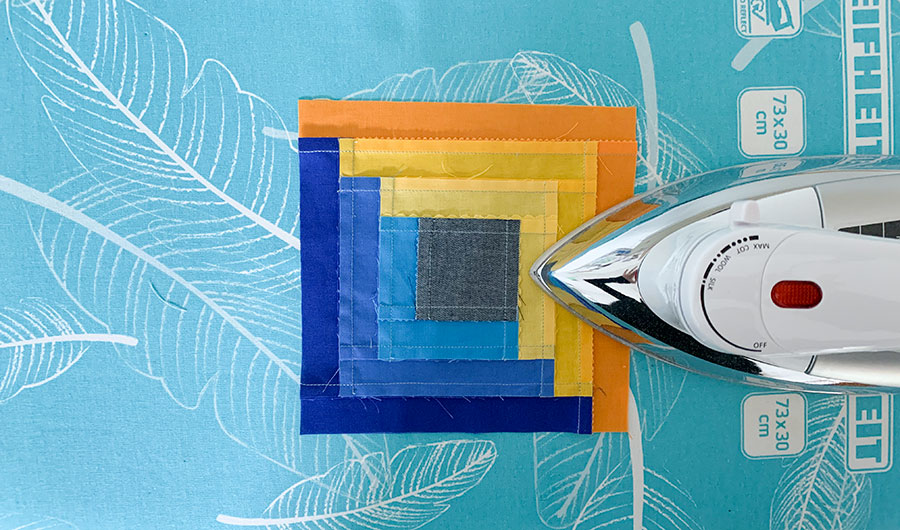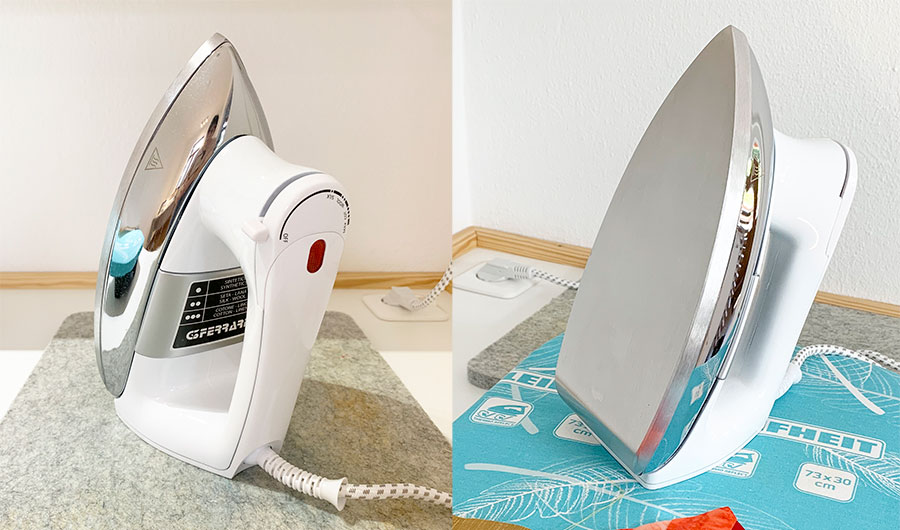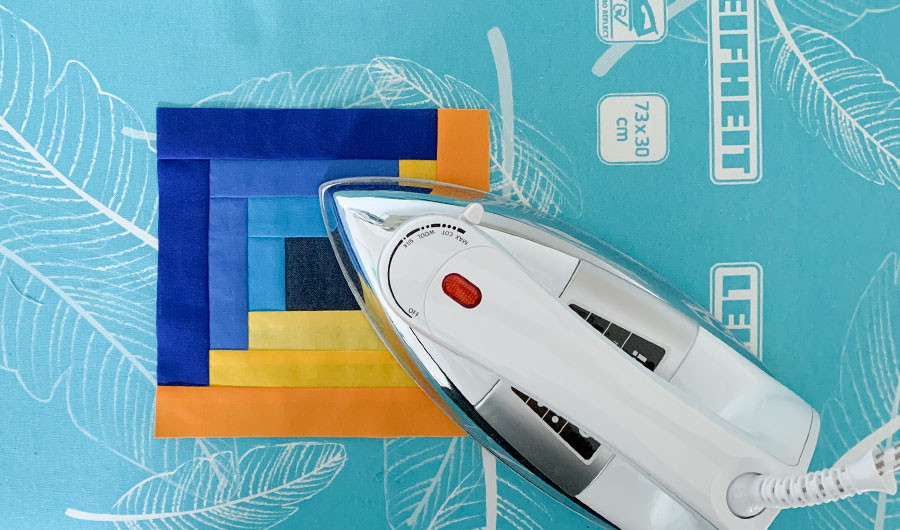Patchwork ironing is a crucial step for optimal results. If you are not careful here, it will affect the whole quilt later. That’s why it’s really worthwhile to find the best iron for you. For clothes, this is clearly a steam iron, but in patchwork?
The search for the perfect iron
Naturally! I love patchwork and everything that has to do with it. When I’m finally sitting in my mini sewing studio and fiddling around, I can immerse myself in my world. But there is also one or the other side thing that I enjoy and that includes researching new products, trends, manufacturers, artists and techniques. Of course, I try the depths of the Internet, but I also consult with other women and ask about their experiences or write to manufacturers if I need tutoring in terms of technology. In this way, I gather a small wealth of experience over months and form an opinion.
In the last few weeks I (together with my favorite craftsmen ;-)) have finished my sewing workshop. And in the course of this I also bought a few things, including a new iron. I iron clothes on the top floor of the house, but my new room is on the ground floor – and nothing is further from my mind than carrying my iron around the house every day. In the back of my mind, the topic of “ironing in patchwork” has been on my mind for a long time, because with the Lizzy Albright sew-along I once again shrunk two blocks with steam so much that I had to sew them again. And no: deactivating the steam function on a steam iron does not bring the necessary effect for me . And that’s the case with all the models I’ve tried so far (I’ve been able to try out several during courses or here at home over the years). There is also something else: I like to work with white fabrics and have often been annoyed by limescale that is emitted during vaping. And that although I diligently use the descaling function.
What do I expect from an iron?
That sounds funny at first, but it’s also worth thinking about in this case:

- It should also iron small blocks with lots of seam allowances as flat as possible
- It should be of high quality and durable – of course you can’t know that beforehand, but I read reviews and also keep an eye on how manufacturers react to customer questions
- It may also look nice (iron in particular can be really terribly ugly) – of course, proper function is paramount, but if I have the choice, I also look at the outside
- The weight should be as high as possible (I’ll go into that later)
- If possible, the manufacturer should have a whole range of irons in their range – this gives me a good feeling of professionalism and experience in this area
How do others iron in patchwork?
What I really love about patchwork is the large community that you hang out in. It is a great pleasure to exchange ideas with you and to share the treasures of experience! When it came to ironing patchwork, that didn’t do me any good, for once, because everyone I asked ironed without exception with steam irons that had the steam function deactivated. In Youtube videos you can see that luminaries like Jenny Doan or Donna Jordan are using the steam functions like crazy. That’s also completely ok if you basically iron all blocks equally. But with a sew-along, which takes a long time, you simply work differently from week to week, depending on the block and the number of seam allowances.
Many traditional patchworkers are totally opposed to steaming because of course it greatly affects the fabric through the combination of heat and moisture. So what now? I myself have never seen anything other than steam irons. I seem to remember that my grandmother had a classic flat iron. During our studies we worked in the sewing studios on gigantic ironing stations with a suction function. A nice local dry cleaner showed me what the professional works with – and lo and behold: a dry iron is standard there. However, only in connection with a huge, room-high, high-voltage thing dabumsda, to which all devices are connected. However, these do not have their own power supply or the classic plug that we know from our household appliances. In a Chatterbox Quilts YouTube video, Kim Jamieson-Hirst briefly referred to her iron with the words “I always iron without steam”, an iron without the well-known holes in the soleplate. Aha! Hmmm …. I stayed there.
Ironing with a steam iron without steam?
That just doesn’t result in optimally flat seams for me! That’s actually logical, because where the holes for the steam outlet are, no heat can be transferred to the fabric. The contact surface is therefore smaller than that of a dry iron. If you use a steam iron without steam, the full range of functions is not available. Steam irons advertise with the greatest sliding soles – that’s not a convincing argument either, because I don’t move the iron back and forth, I just press. Of course, the soleplate should be smooth, but we simply don’t need an extra expensive coating in patchwork.
Deciding on a dry iron
The decision had been made, I just wanted to try something new. Nothing ventured nothing gained! So on the World Wide Web and in the chats in search of THE iron! I can anticipate one thing: it wasn’t easy, because dry irons are a dying breed…
How do I research?
The art of research lies in finding the right search term, i.e. the correct product name, at the beginning. So I started by typing “iron without steam” and found the word “dry iron”. When searching for a product that is limited to Germany, you quickly reach the limits of the product variety, because there are not many models on the market. The purchasable dry irons all advertise that they are particularly light and small or with keywords such as “replacement for the steam ironing station when you travel” etc. No, no, that’s not the right thing …. Also the prices under 20 € doesn’t exactly inspire my confidence, because I wanted to buy quality.
I also did a quick search on English-language patchwork websites, but then realized immediately that it was of no use at all due to the different plug types. And since irons have a high wattage, I don’t want to fiddle around with any adapters in this area. So back to Europe.
When reading reviews in the shop of the large, ubiquitous online retailer, I noticed that many customer testimonials were in Italian … hmmm, what’s that all about? I agree! Ironing without steam is much more common in Italy. I don’t speak Italian, but you can still find the search term with a translator, it is: “Ferro da stiro a secco” which means something like “dry iron”. And so I finally came across “my” model and ordered it! Tadaaaaaaa …… May I introduce: the G3 Ferrari Seicento (Note: I do not receive any credit for naming the brand name and product)

Both the product description and customer reviews convinced me. The negative comments were either related to the heavy weight, as some might find it cumbersome, and the soleplate, which due to the height offers more contact surface for accidental touches/burns. But in addition to the chic retro look and the color (white is my thing), it was the high weight that appealed to me!
Why I value a high weight
With patchwork, you press the soleplate onto the fabric, because the combination of heat and pressure results in flat seams. However, I have quite sensitive wrists and if I sew diligently and press blocks, it is possible that my wrists will hurt slightly the next day. That’s why the heavy weight of the iron is very important to me, because the heavier it is, the less pressure I have to exert myself – and with this model I just place the iron on the seam allowances and wait a few seconds. Brilliant!

According to the manufacturer, the iron weighs 1.6 kg, my scale shows 1.495 kg. For me personally it feels great to press as all I have to do is place seam allowances as needed and put on the dry iron, wait a few seconds and you’re done!
Ironing in patchwork? With a dry iron!
I’ve been using the iron for 5 weeks now and I love it. But my steam iron can continue to iron my shirts and blouses. I also showed the iron in an Instagram video because you can see the proportion better there because I’m holding it in my hand. Feel free to stop by there if you have the time and inclination.
